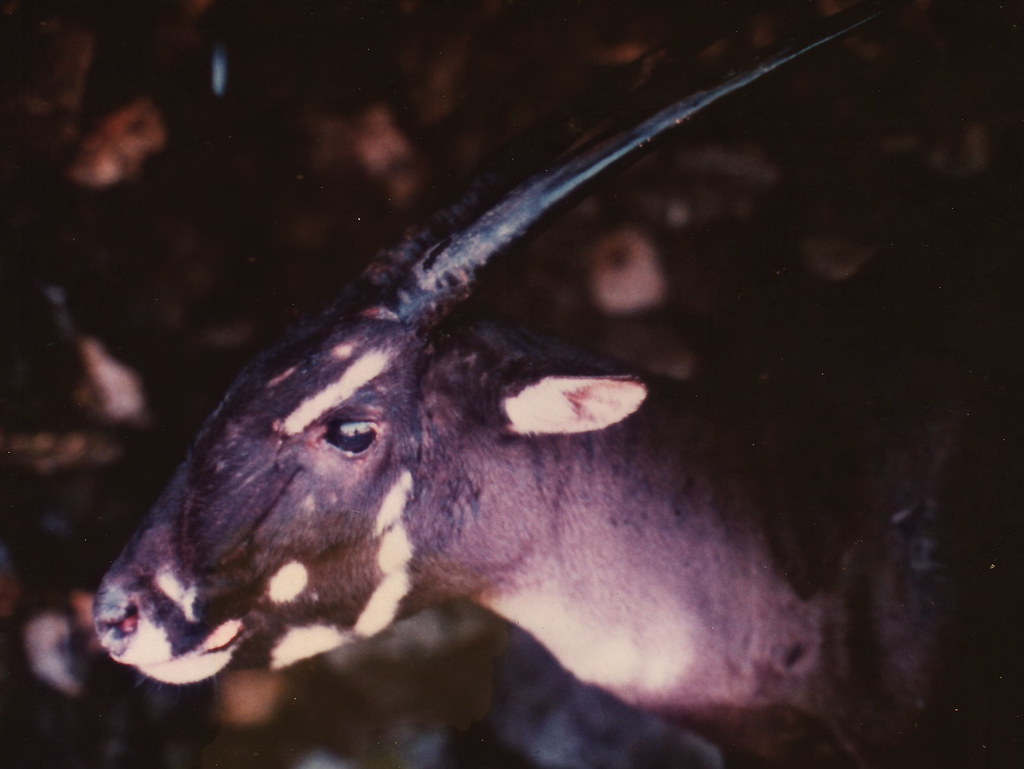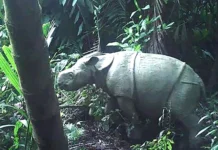The Saola (Pseudoryx nghetinhensis), often referred to as the “Asian unicorn,” is one of the most enigmatic and critically endangered species on Earth. Discovered only in 1992, the Saola is a bovid native to the Annamite Mountains on the border between Vietnam and Laos. With fewer than 100 individuals estimated to remain in the wild, the Saola is facing an uncertain future and is considered one of the world’s rarest and most elusive mammals.

In this article, we will explore the biology, behavior, habitat, and conservation challenges faced by the Saola, as well as the ongoing efforts to ensure its survival.
Discovery and Name
The Saola’s discovery in 1992 was an unexpected revelation that left the scientific community in awe. Prior to this, no one had ever recorded the Saola, and its existence was completely unknown to researchers. The first specimens were discovered by a joint Vietnamese and Lao expedition in the Annamite Mountains, a region that is difficult to access due to its rugged terrain. The discovery of the Saola marked a major milestone in mammal research, as it was the first new large mammal to be identified in over 50 years.
The name “Saola” comes from the Vietnamese word for the species, “sao la,” which refers to its distinctive, sharp, and spiral-shaped horns. Sometimes referred to as the “Asian unicorn,” the Saola’s rarity and the elusive nature of the species have earned it this nickname, though it is not related to the mythical creature of the same name.
Physical Characteristics
The Saola is a medium-sized bovid with distinctive features that set it apart from other species. It has a relatively slim, elongated body and stands about 80 cm (31 inches) tall at the shoulder. Adult males can weigh up to 100 kg (220 pounds), while females tend to be smaller, weighing between 40 and 60 kg (88 to 132 pounds).
One of the most striking features of the Saola is its long, spiraled horns, which can grow up to 50 cm (20 inches) long. These horns are present in both males and females, though they are typically more prominent in males. The horns are used in territorial displays and battles with other Saolas, particularly during mating season.
The coat of the Saola is smooth and dark brown, with white markings on the face, and it has a white stripe running down the side of its body. This color pattern helps it blend into the dense forests and mountainous regions where it lives. The Saola’s large eyes, pointed ears, and slender legs give it an elegant and well-adapted appearance for its environment.
Habitat and Distribution
The Saola’s natural habitat is the dense tropical forests of the Annamite Mountains, a remote and rugged mountain range that forms the border between Vietnam and Laos. The region is characterized by steep slopes, fast-flowing rivers, and dense vegetation, which makes it difficult to access and study the animals that live there.
The Saola is believed to be a forest-dwelling species, preferring to live in remote, high-altitude regions. The habitat is largely undisturbed by human activity, which is likely why the Saola has remained so elusive. The Annamite Mountains are home to a variety of wildlife, including other rare species such as the clouded leopard, the red-shanked douc langur, and the giant muntjac. The region’s biodiversity and relatively pristine ecosystem make it an important area for wildlife conservation.
Despite the Saola’s restricted range, its population is not evenly distributed. The species tends to occupy areas where dense vegetation and water sources are available, but it is believed that human activities, such as hunting and logging, have further limited its habitat and fragmented its population.
Behavior and Diet
The Saola is a shy and elusive animal, rarely seen by humans. Due to the difficulty of studying the species in the wild, much of what is known about its behavior is based on indirect evidence, such as footprints and camera trap footage. It is believed that the Saola is a solitary animal, living alone or in small family groups. It is most active during the early morning and late afternoon, when it emerges from its forest cover to feed.
As a herbivore, the Saola primarily feeds on grasses, shrubs, and leaves. It is known to inhabit areas near rivers and streams, which provide both food and water. The Saola’s diet is thought to consist of a wide variety of plant species, although detailed studies of its feeding habits are limited. The Saola is also known to be highly selective in its choice of food, often preferring certain species of plants over others.
Due to the dense and rugged nature of its habitat, the Saola is well adapted for navigating through thick vegetation. Its slender legs and hooves enable it to move silently and swiftly through the forest floor, and it is believed to be able to leap over obstacles such as rocks and logs.
Reproduction and Life Cycle
Very little is known about the Saola’s reproductive behavior, as sightings of mating pairs and young individuals are extremely rare. However, it is believed that the Saola has a relatively slow reproductive rate, similar to other large mammals. Saolas typically give birth to a single offspring, although twins have occasionally been recorded in other bovid species. The gestation period is thought to be around nine months, after which the female gives birth to a calf, which is highly dependent on its mother for survival.
Saola calves are believed to remain with their mothers for several months, during which time they learn to forage and navigate the forest. As with many large herbivores, the Saola’s reproductive rate is slow, and it takes several years for young Saolas to reach maturity. Due to the species’ limited range and small population, reproduction rates are crucial to the survival of the Saola.
Threats to the Saola
The Saola is facing a range of threats that have contributed to its critically low population. Some of the key factors that are putting the Saola at risk include:
- Habitat Destruction and Fragmentation: The Annamite Mountains, where the Saola lives, are under threat from logging, infrastructure development, and agricultural expansion. As forests are cleared for farming and timber, Saola habitats are destroyed or fragmented, leaving populations isolated in small, disconnected pockets of land. This not only reduces the amount of suitable habitat for the Saola but also makes it harder for individuals to find mates and reproduce.
- Poaching: The Saola has been targeted by poachers for its horns and for bushmeat. Although the species is protected by law, illegal hunting continues to be a significant threat. The Saola is often trapped unintentionally in snares set for other wildlife, further exacerbating its decline.
- Climate Change: Climate change poses an indirect threat to the Saola’s survival. As temperatures rise and weather patterns change, the delicate ecosystems of the Annamite Mountains may be altered, further reducing the availability of suitable habitat for the Saola. Climate change could also exacerbate existing threats, such as habitat destruction and the spread of diseases.
- Low Reproductive Rate: The Saola’s slow reproductive rate means that its population is highly sensitive to any form of population decline. Even small losses can have a significant impact on the species’ ability to recover.
Conservation Efforts
Conservationists and wildlife organizations have made significant efforts to protect the Saola, but much remains to be done. Some of the key conservation efforts include:
- Protected Areas: The establishment of protected areas in the Annamite Mountains is one of the most important steps in conserving the Saola. Both Vietnam and Laos have set aside regions of the mountains as wildlife reserves to prevent logging, hunting, and other human activities that threaten the Saola.
- Anti-Poaching Initiatives: Efforts to combat poaching and illegal hunting are crucial to the Saola’s survival. Local communities are being educated about the importance of protecting the species, and anti-poaching patrols are being conducted to remove snares and prevent illegal hunting.
- Research and Monitoring: Ongoing research and monitoring efforts are vital for understanding the Saola’s behavior, habitat requirements, and population dynamics. Camera traps, GPS tracking, and other tools are used to monitor the species in the wild, allowing conservationists to track its movements and assess the effectiveness of conservation strategies.
- Captive Breeding Programs: While there is no captive breeding program for the Saola at this time, there is potential for future efforts to protect the species through breeding and reintroduction initiatives. Given the species’ rarity, successful breeding in captivity would be a significant step in ensuring its survival.
Conclusion
The Saola is one of the most critically endangered species on the planet, with fewer than 100 individuals left in the wild. Its slow reproductive rate, coupled with habitat destruction, poaching, and climate change, has left the species on the brink of extinction. However, with continued conservation efforts, there is hope that the Saola may be able to recover. Protecting its habitat, reducing human-wildlife conflict, and increasing public awareness are essential steps in ensuring that this remarkable and elusive animal survives for future generations.
The Saola’s story is a reminder of the fragility of the natural world and the urgent need for conservation action to preserve the incredible biodiversity that remains on our planet.





























